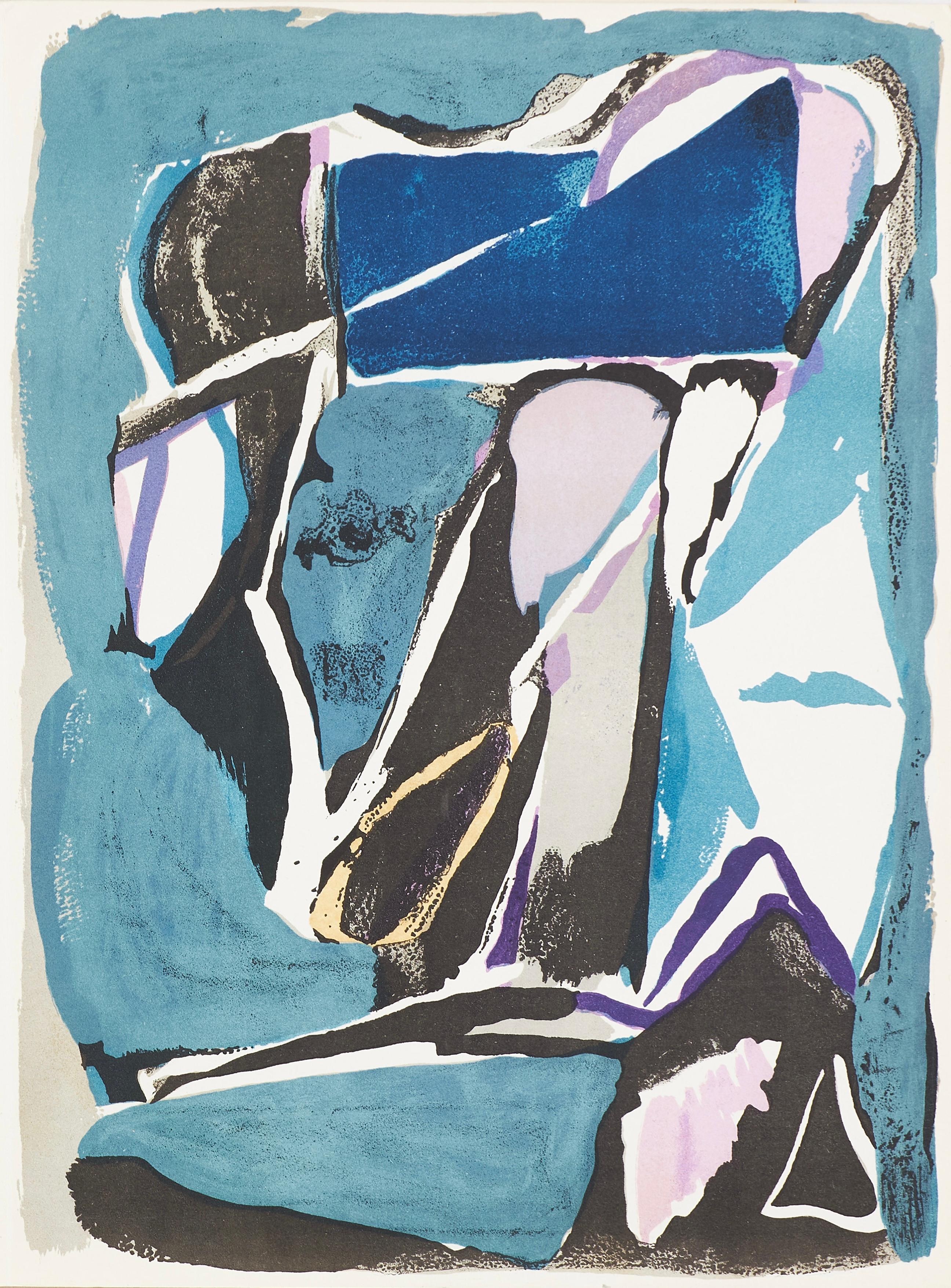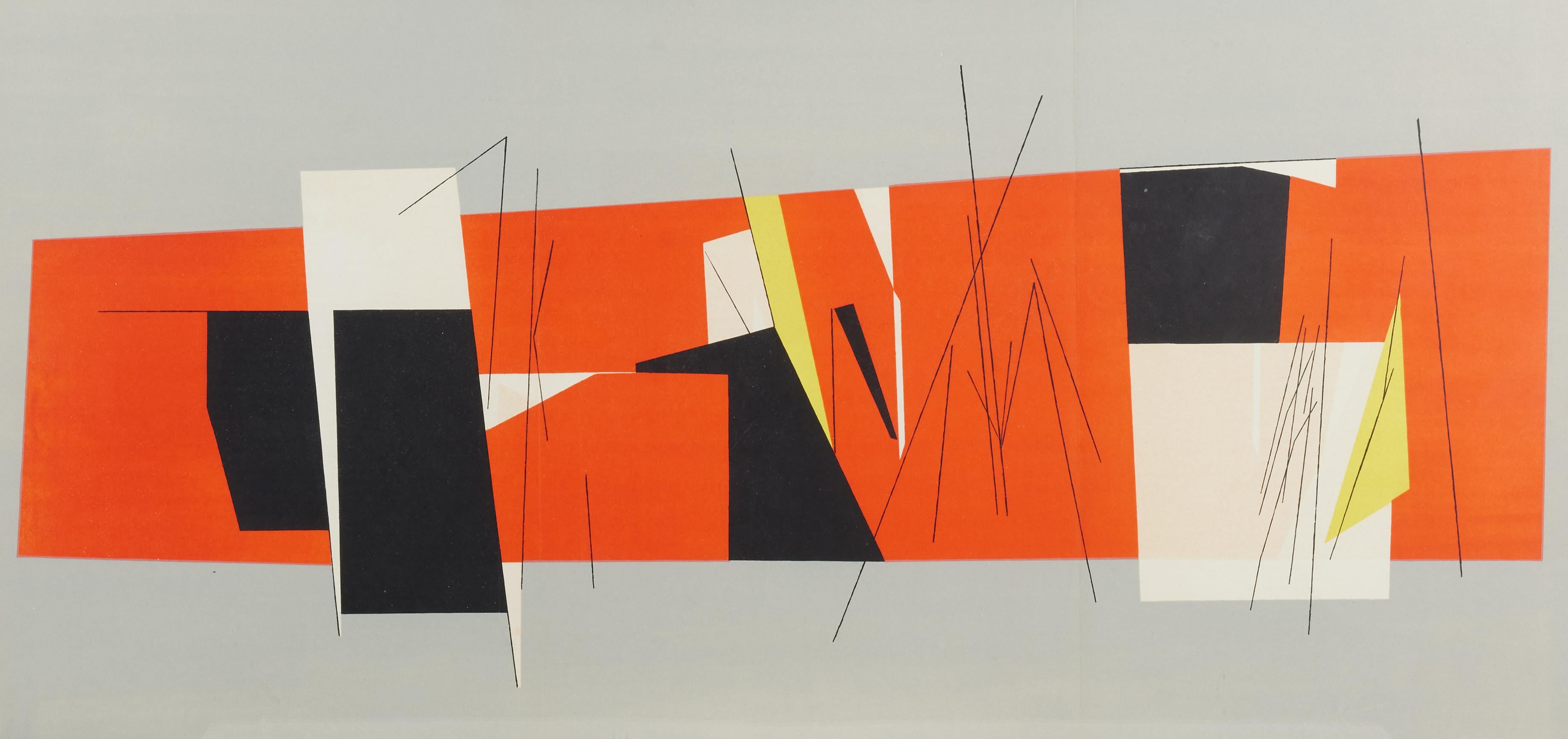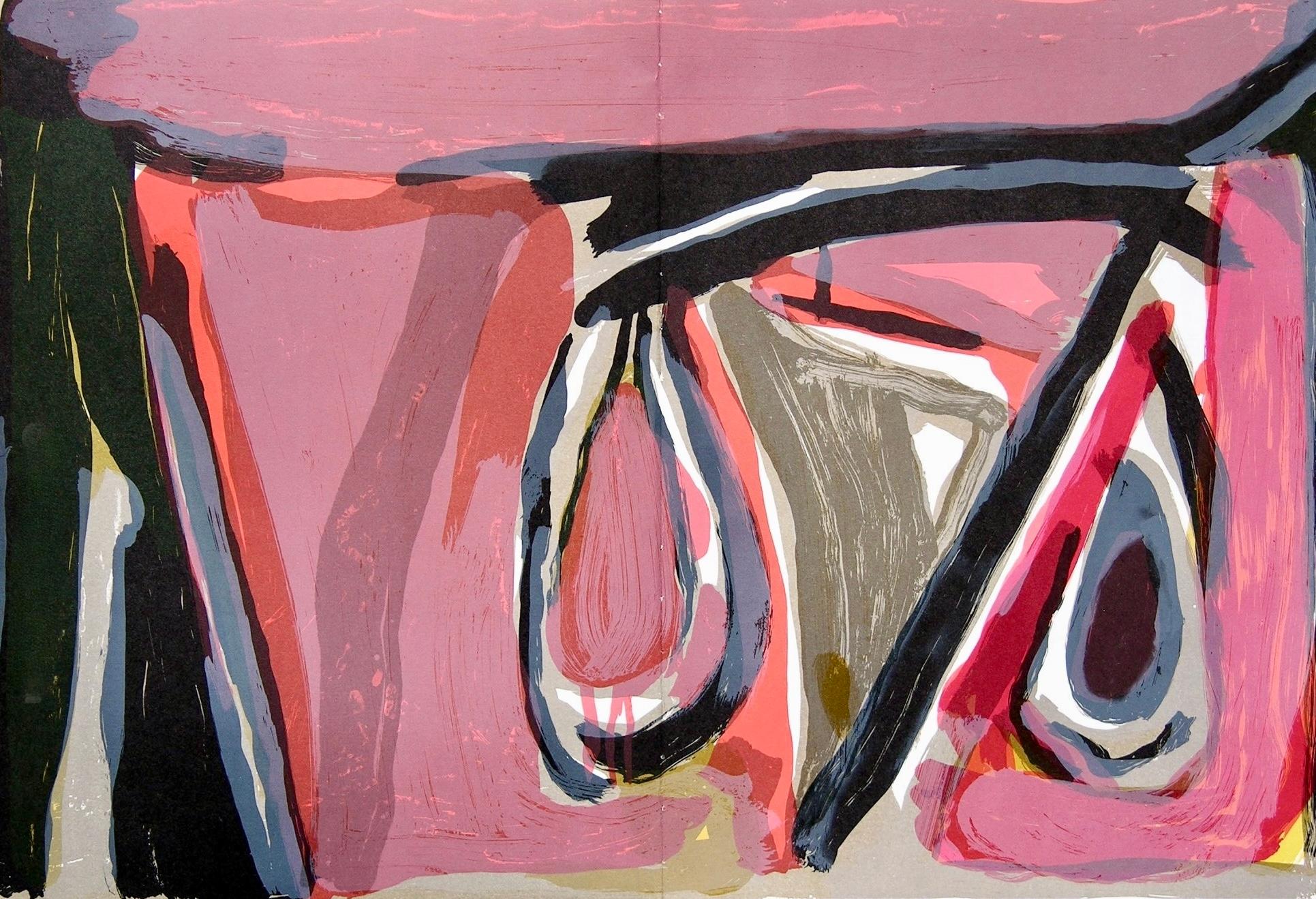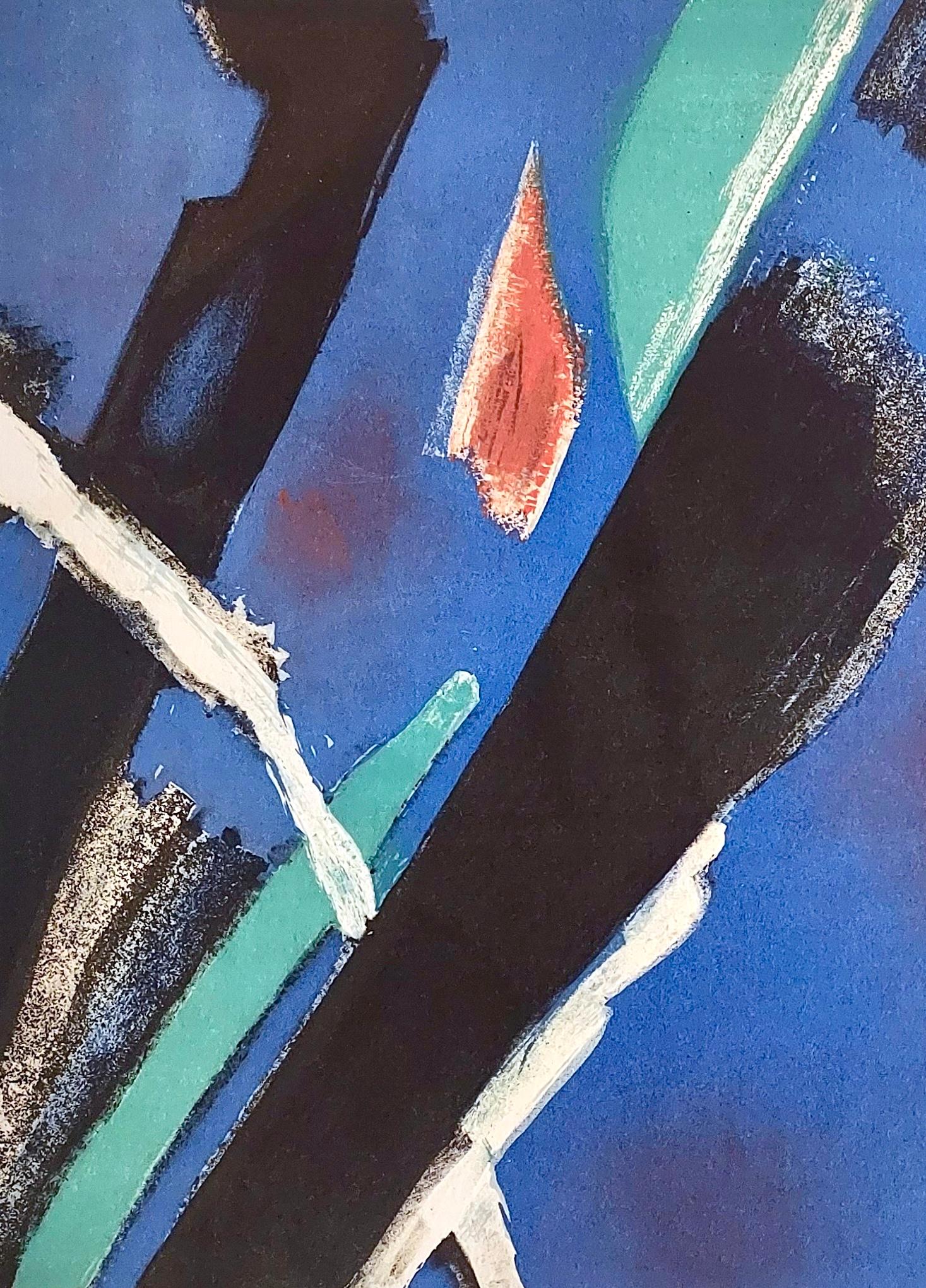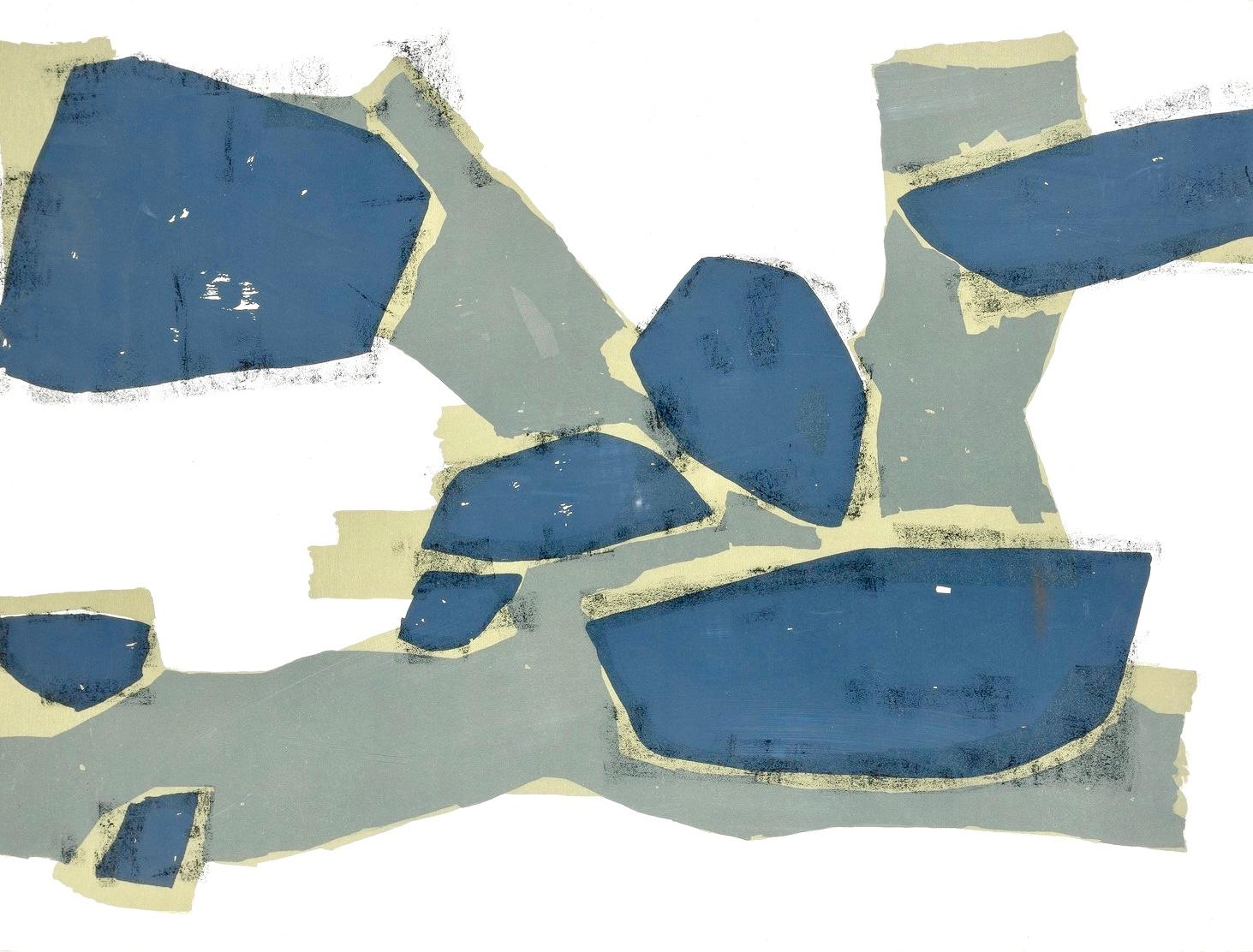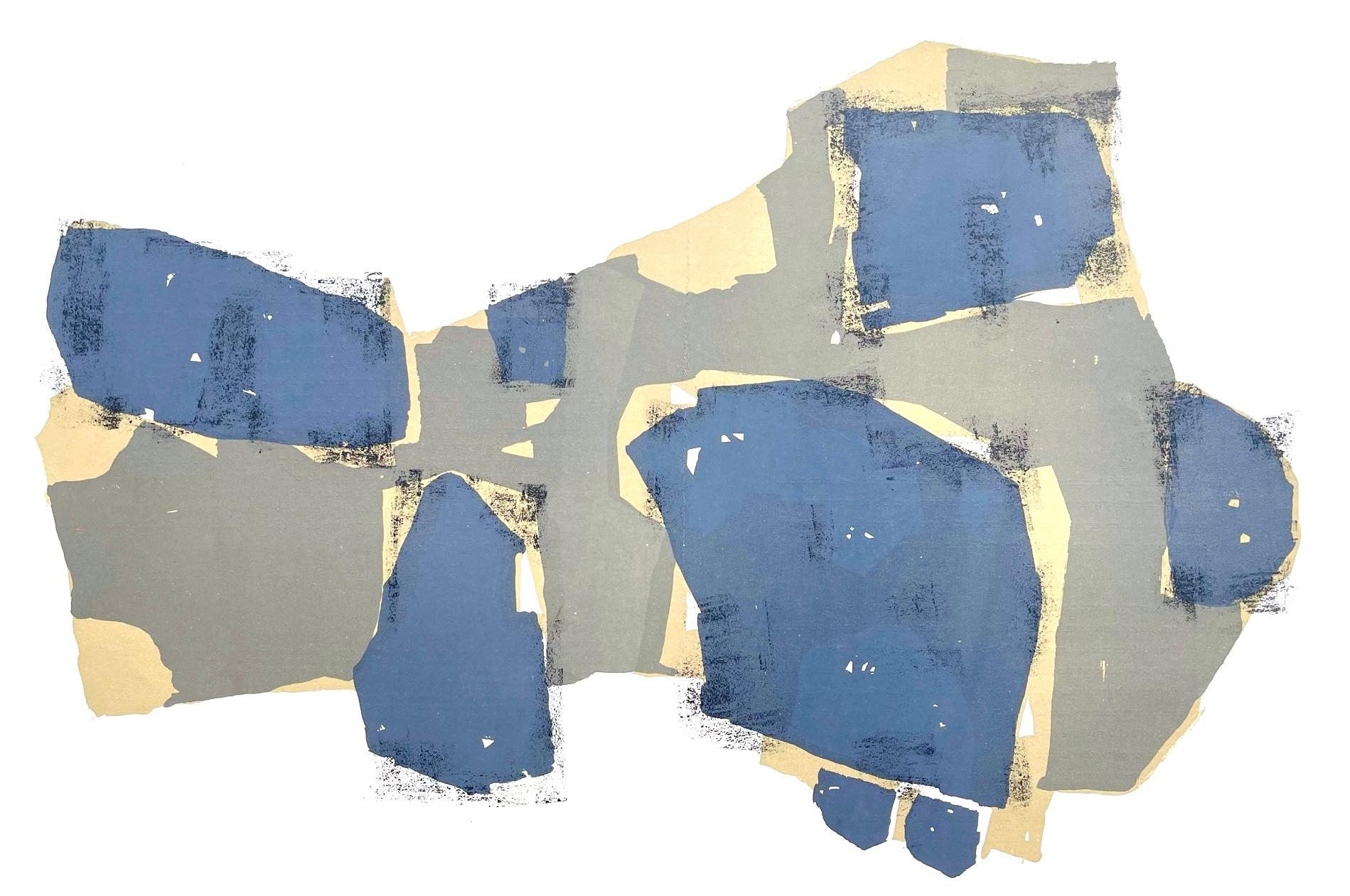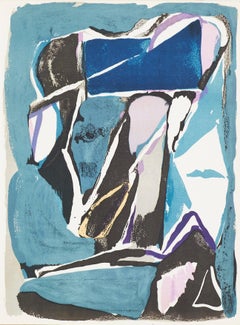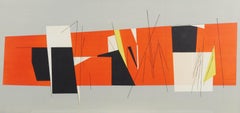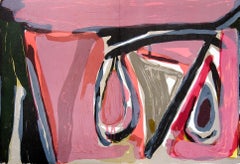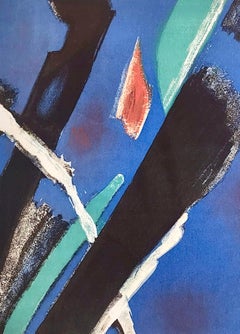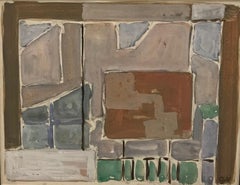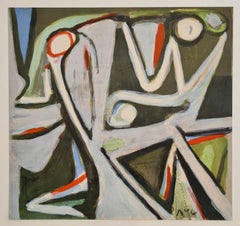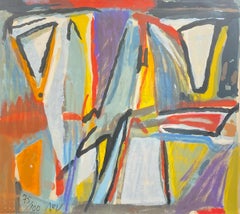Items Similar to Geer van Velde, Untitled, from Derriere le miroir, 1952
Want more images or videos?
Request additional images or videos from the seller
1 of 10
Geer Van VeldeGeer van Velde, Untitled, from Derriere le miroir, 19521952
1952
$716
$89520% Off
£557.45
£696.8220% Off
€633.99
€792.4820% Off
CA$1,029.94
CA$1,287.4320% Off
A$1,131.58
A$1,414.4720% Off
CHF 591.37
CHF 739.2120% Off
MX$13,495
MX$16,868.7520% Off
NOK 7,488.34
NOK 9,360.4220% Off
SEK 6,976.02
SEK 8,720.0220% Off
DKK 4,737.44
DKK 5,921.8020% Off
About the Item
This exquisite lithograph by Geer van Velde (1898–1977), titled Sans titre (Untitled), from the folio Derriere le miroir, No. 51, originates from the 1952 edition published by Maeght Editeur, Paris, and printed by Mourlot Freres, Paris, 1952. With its poised geometry, quiet luminosity, and meditative rhythm, this composition exemplifies van Velde’s serene and architectural approach to abstraction—an art of balance, harmony, and contemplation.
Executed as a lithograph on velin paper, this work measures 15 x 22 inches, with centerfold as issued. Signed in the plate and unnumbered as issued. The edition exemplifies the superb craftsmanship of Mourlot Freres, Paris.
Artwork Details:
Artist: Geer van Velde (1898–1977)
Title: Sans titre (Untitled), from the folio Derriere le miroir, No. 51
Medium: Lithograph on velin paper
Dimensions: 15 x 22 inches (38.1 x 55.9 cm), with centerfold as issued
Inscription: Signed in the plate and unnumbered as issued
Date: 1952
Publisher: Maeght Editeur, Paris
Printer: Mourlot Freres, Paris
Condition: Well preserved, consistent with age and medium
Provenance: From the folio Derriere le miroir, No. 51, published by Maeght Editeur, Paris; printed by Mourlot Freres, Paris, 1952
About the Publication:
Derriere le miroir (Behind the Mirror) was one of the most important art publications of the 20th century, created and published by Maeght Editeur in Paris from 1946 to 1982. Founded by the visionary art dealer and publisher Aime Maeght, the series served as both an exhibition catalogue and a work of art in its own right, uniting original lithographs by leading modern and contemporary artists with critical essays, poetry, and design of the highest quality. Printed by master lithographers such as Mourlot Freres and Arte, Derriere le miroir became synonymous with the artistic vanguard of postwar Europe. Each issue was devoted to a single artist or theme and published to accompany exhibitions at the Galerie Maeght in Paris, featuring works by Pablo Picasso, Henri Matisse, Georges Braque, Joan Miro, Marc Chagall, Alexander Calder, Fernand Leger, and Alberto Giacometti, among others. The publication reflected Maeght’s belief that art should be both accessible and elevated—an ideal realized through its luxurious production values, meticulous printing, and collaboration with the greatest creative minds of its time.
About the Artist:
Geer van Velde (1898–1977) was a Dutch painter whose luminous abstractions, architectural precision, and meditative restraint established him as one of the quiet masters of modern European painting. Born in Lisse, the Netherlands, he was the younger brother of Bram van Velde, and though both shared a devotion to abstraction, their sensibilities diverged dramatically—Bram’s art was emotive and existential, while Geer’s was ordered, rational, and imbued with an inner harmony that reflected his search for balance and transcendence through form. Largely self-taught, Geer began as a house painter before dedicating himself fully to art, developing through close study of the modern masters. When he moved to Paris in the 1920s, the city’s avant-garde profoundly shaped his vision. Immersed in the circles of Pablo Picasso, Wassily Kandinsky, Joan Miro, Salvador Dali, Alexander Calder, Marcel Duchamp, and Man Ray, he absorbed the formal lessons of Cubism, the lyrical symbolism of Surrealism, and the structural clarity of Constructivism. Over time, van Velde synthesized these influences into an aesthetic that sought serenity through geometric precision and the orchestration of color and light. His paintings, defined by interlocking planes, transparency, and quiet tonal variation, achieve a sense of equilibrium that merges intellect with emotion and structure with contemplation. A key figure of the School of Paris, he exhibited alongside Jean Helion, Jean Fautrier, and Nicolas de Stael, who shared his pursuit of a lyrical abstraction that transcended mere form. Critics often described his compositions as “architectures of silence,” noting how their subtle rhythm and balance evoked an almost spiritual calm. His work stands in dialogue with that of Piet Mondrian and Ben Nicholson but with a more human and introspective sensitivity, his restrained palette creating a meditative space between materiality and light. His influence extended to later artists including Pierre Soulages, Serge Poliakoff, Hans Hartung, and Zao Wou-Ki, as well as American minimalists who admired his disciplined spatial awareness and compositional purity. Van Velde’s art, while tranquil, carries immense emotional depth, revealing his belief that abstraction could serve as a bridge between order and feeling. Exhibited widely in Paris, Brussels, and Amsterdam, his works now reside in the Centre Pompidou, the Stedelijk Museum Amsterdam, the Musee d’Art Moderne de la Ville de Paris, and the Kunstmuseum Basel. The highest auction record for Geer van Velde was achieved in 2014 when his painting Composition (1955) sold for 463,000 USD at Sotheby’s Paris, affirming his legacy as one of the most contemplative and refined abstractionists of the 20th century.
Geer van Velde Sans titre Derriere le miroir No. 51, Geer van Velde Mourlot Freres, Geer van Velde Maeght Editeur, Geer van Velde velin paper, Geer van Velde collectible lithograph.
- Creator:Geer Van Velde (1898 - 1977, Dutch)
- Creation Year:1952
- Dimensions:Height: 15 in (38.1 cm)Width: 22 in (55.88 cm)
- Medium:
- Movement & Style:
- Period:
- Condition:
- Gallery Location:Southampton, NY
- Reference Number:1stDibs: LU1465216420252
About the Seller
4.9
Platinum Seller
Premium sellers with a 4.7+ rating and 24-hour response times
Established in 1978
1stDibs seller since 2021
1,223 sales on 1stDibs
Typical response time: <1 hour
- ShippingRetrieving quote...Shipping from: Southampton, NY
- Return Policy
More From This Seller
View AllBram van Velde, Blue Form, from Derriere le miroir, 1952
By Bram Van Velde
Located in Southampton, NY
This exquisite lithograph by Bram van Velde (1895–1981), titled Formulaire bleu (Blue Form), from the folio Derriere le miroir, No. 43, originates from the 1952 edition published by ...
Category
1950s Modern Abstract Prints
Materials
Lithograph
$716 Sale Price
20% Off
Free Shipping
Pablo Palazuelo, Untitled, from Derriere le miroir, 1952
By Pablo Palazuelo
Located in Southampton, NY
This exquisite lithograph by Pablo Palazuelo (1916–2007), titled Sans titre (Untitled), from the folio Derriere le miroir, Tendance, No. 50, originates from the 1952 edition publishe...
Category
1950s Modern Abstract Prints
Materials
Lithograph
$716 Sale Price
20% Off
Free Shipping
Bram van Velde, Composition, from Derriere le Miroir, 1982 (after)
By Bram Van Velde
Located in Southampton, NY
This exquisite lithograph after Bram van Velde (1895–1981), titled Composition, originates from the historic 1982 folio Derriere le Miroir, No. 250, Hommage a Aime et Marguerite Maeg...
Category
1980s Modern Abstract Prints
Materials
Lithograph
$716 Sale Price
20% Off
Free Shipping
Jean Bazaine, Blue Composition, from Derriere le miroir, 1953
By Jean Bazaine
Located in Southampton, NY
This exquisite lithograph by Jean Bazaine (1904–2001), titled Composition bleue (Blue Composition), from the folio Derriere le miroir, No. 55-56, originates from the 1953 edition pub...
Category
1950s Modern Abstract Prints
Materials
Lithograph
$716 Sale Price
20% Off
Free Shipping
Raoul Ubac, Untitled, from Derriere le miroir, 1955
By Raoul Ubac
Located in Southampton, NY
This exquisite lithograph by Raoul Ubac (1910–1985), titled Sans titre (Untitled), from the folio Derriere le miroir, No. 74-76, originates from the 1955 edition published by Maeght ...
Category
1950s Modern Abstract Prints
Materials
Lithograph
$716 Sale Price
20% Off
Free Shipping
Raoul Ubac, Untitled, from Derriere le miroir, 1955
By Raoul Ubac
Located in Southampton, NY
This exquisite lithograph by Raoul Ubac (1910–1985), titled Sans titre (Untitled), from the folio Derriere le miroir, No. 74-76, originates from the 1955 edition published by Maeght ...
Category
1950s Modern Abstract Prints
Materials
Lithograph
$716 Sale Price
20% Off
Free Shipping
You May Also Like
Composition
By Geer Van Velde
Located in Paris, FR
Gouache, ca1950
Handsigned by the artist in pencil
22.00 cm. x 28.00 cm. 8.66 in. x 11.02 in. (image)
Framed work
Gouache on paper
A certificate of authenticity etaliblished by Pie...
Category
1950s Abstract Abstract Paintings
Materials
Gouache
Hinged Reflection
Located in Kansas City, MO
Warren Rosser
Hinged Reflection
Year: 2003
8 Color Lithograph
Edition: 30
Paper: Rives BFK
Paper Size: 30.25 x 82.5 inches (two sheets joined)
Image Size: Same
Signed and numbered by...
Category
Early 2000s Abstract Abstract Prints
Materials
Lithograph
$5,555 Sale Price
30% Off
Désertique
By Bram Van Velde
Located in Paris, FR
Lithograph, 1981
Handsigned by the artist in pencil and numbered 45/100
Publisher : Maeght - Lelong SA (Paris)
Printer : Pierre Badey (Paris)
Catalog : Mason Putman 390
LCD5156
Category
1980s Abstract Abstract Prints
Materials
Lithograph
Abstract (Edition 75/100)
By Bram Van Velde
Located in Missouri, MO
Abstract (Edition 75/100)
By Bram Van Velde (1895-1981)
Numbered Lower Left
Signed Lower Center
Unframed: 25" x 28"
Framed: 31.5" x 34.5"
Bram (Abraham Gerardus) van Velde was a Dutch painter known for an intensely colored and geometric semi-representational painting style related to Tachisme*, and Lyrical Abstraction*. He is often seen as member of the School of Paris* but his work resides somewhere between expressionism* and surrealism*, and evolved in the 1960s into an expressive abstract art. His paintings from the 1950s are similar to the contemporary work of Matisse, Picasso and the abstract expressionist Adolph Gottlieb. He was championed by a number of French-speaking writers, including Samuel Beckett and the poet André du...
Category
20th Century Abstract Abstract Prints
Materials
Lithograph
Price Upon Request
Abstract (Edition 95/100)
By Bram Van Velde
Located in Missouri, MO
Abstract (Edition 95/100)
By Bram Van Velde (1895-1981)
Numbered Lower Left
Signed Lower Center
Unframed: 37" x 24"
Framed: 37.5" x 25.25"
Bram (Abraham Gerardus) van Velde was a Dutch painter known for an intensely colored and geometric semi-representational painting style related to Tachisme*, and Lyrical Abstraction*. He is often seen as member of the School of Paris* but his work resides somewhere between expressionism* and surrealism*, and evolved in the 1960s into an expressive abstract art. His paintings from the 1950s are similar to the contemporary work of Matisse, Picasso and the abstract expressionist Adolph Gottlieb. He was championed by a number of French-speaking writers, including Samuel Beckett and the poet André du...
Category
20th Century Abstract Abstract Prints
Materials
Lithograph
Price Upon Request
Untitled
By Charles Houghton Howard
Located in New York, NY
Charles Houghton Howard was born in Montclair, New Jersey, the third of five children in a cultured and educated family with roots going back to the Massachusetts Bay colony. His father, John Galen Howard, was an architect who had trained at M.I.T. and the École des Beaux-Arts in Paris and apprenticed in Boston with Henry Hobson Richardson. In New York, the elder Howard worked for McKim, Mead and White before establishing a successful private practice. Mary Robertson Bradbury Howard, Charles’s mother, had studied art before her marriage. John Galen Howard moved his household to California in 1902 to assume the position of supervising architect of the new University of California campus at Berkeley and to serve as Professor of Architecture and the first Dean of the School of Architecture (established in 1903). The four Howard boys grew up to be artists and all married artists, leaving a combined family legacy of art making in the San Francisco Bay area that endures to this day, most notably in design, murals, and reliefs at the Coit Tower and in buildings on the Berkeley campus.
Charles Howard graduated from the University of California at Berkeley in 1921 as a journalism major and pursued graduate studies in English at Harvard and Columbia Universities before embarking on a two-year trip to Europe. Howard went to Europe as a would-be writer. But a near-religious experience, seeing a picture by Giorgione in a remote town outside of Venice, proved a life-altering epiphany. In his own words, “I cut the tour at once and hurried immediately back to Paris, to begin painting. I have been painting whenever I could ever since” (Charles Howard, “What Concerns Me,” Magazine of Art 39 [February 1946], p. 63). Giorgione’s achievement, in utilizing a structured and rational visual language of art to convey high emotion on canvas, instantly convinced Howard that painting, and not literature, offered the best vehicle to express what he wanted to say. Howard returned to the United States in 1925, confirmed in his intent to become an artist.
Howard settled in New York and supported himself as a painter in the decorating workshop of Louis Bouché and Rudolph Guertler, where he specialized in mural painting. Devoting spare time to his own work, he lived in Greenwich Village and immersed himself in the downtown avant-garde cultural milieu. The late 1920s and early 1930s were the years of Howard’s art apprenticeship. He never pursued formal art instruction, but his keen eye, depth of feeling, and intense commitment to the process of art making, allowed him to assimilate elements of painting intuitively from the wide variety of art that interested him. He found inspiration in the modernist movements of the day, both for their adherence to abstract formal qualities and for the cosmopolitan, international nature of the movements themselves. Influenced deeply by Surrealism, Howard was part of a group of American and European Surrealists clustered around Julien Levy. Levy opened his eponymously-named gallery in 1931, and rose to fame in January 1932, when he organized and hosted Surrealisme, the first ever exhibition of Surrealism in America, which included one work by Howard. Levy remained the preeminent force in advocating for Surrealism in America until he closed his gallery in 1949. Howard’s association with Levy in the early 1930s confirms the artist’s place among the avant-garde community in New York at that time.
In 1933, Howard left New York for London. It is likely that among the factors that led to the move were Howard’s desire to be a part of an international art community, as well as his marriage to English artist, Madge Knight...
Category
20th Century American Modern Abstract Drawings and Watercolors
Materials
Paper, Gouache, Graphite
